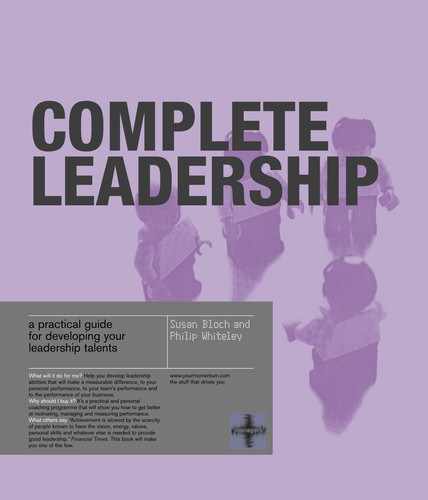
One point to emphasize is that we exhibit some or all of these styles
whether we recognize this or not. This will become evident as you begin
the self-assessment and gather the feedback from your direct reports.
There is no such thing as neutral, or emotion-free, leadership. Every
interaction we have with our boss or our direct reports constitutes a
form of relationship, and the more impersonal or ‘rational’
approaches will show up somewhere on the grid that we set out.
We’ll map your perception of yourself, and those of others working
with you, against six key leadership styles. But before describing the
process, here’s a description of the styles.
The six leadership styles
Authoritative leadership
Authoritative leadership means giving a real sense of direction that is
ambitious, but realistic. It means having a vision, without lapsing
into fantasy. It gives strong direction, but unlike the coercive style,
implicitly acknowledges that employees’ commitment must be
earned. A coercive leader says, ‘Go there!’ An authoritative leader
says, ‘Come with me’. At the very beginning of the book, we noted
a psychological experiment showing how someone in authority can
have great power over individuals. But the experiment in question
involved an authority figure crossing the road despite the ‘WAIT’
sign. Had he or she stayed on the kerb while ordering others to cross,
the result would have been very different.
An authoritative leader never loses sight of the core purpose of the
business and understands that this overriding sense of purpose is
also the matter that most motivates employees. He or she can easily
rise above internal politics, bureaucracy and jargon to see things
from a customer’s perspective and remind people within the
organization what they are there for.
momentum complete leadership chapter three
47
pages 46 /
An authoritative leader never loses sight of the core
purpose of the business.
People want leadership from their leaders. This obvious statement
merits inclusion because sometimes we can be lulled into thinking
that because we are heading a firm of highly intelligent software
developers, say, or a team of able executives, we can let these high-
performing people sort things out for themselves. This is not so. A
leader sets the vision, defines the culture, and sets norms and values
for the group or organization. He or she encourages and coaches
people, but will discipline them if they have broken these agreed
norms and conventions. One recent study concluded: ‘Our research
showed that on outstanding teams the leader gave far clearer
direction than on average or poor-performing teams . . . When the
team leader does not provide it [direction], a leadership vacuum is
created, one that all members rush to fill with their own individual
priorities and goals.’
It added: ‘As CEO you should never assume that because your top
team includes bright, successful individuals, there is no need to
establish clear norms. Our research suggests the opposite is true:
because top teams are composed of such strong personalities, clear
norms are even more important.’
15
If you are feeling unsure about the direction, but sense that the staff
need reassurance, it’s best to map out a vision, and the route to that
goal with the risks involved. The alternative, extreme approaches
that are often taken – to no good effect – are either to pretend there
are no problems or to convey your own anxieties.
Some executives have developed the authoritative style through
training on how to give public speeches or deal with the media. They
conceive of themselves as presenting, or being ‘on stage’ all the time
in management. But this does not mean being fake! In the words of
Barbara Moorhouse, former finance director of IT firm Kewill
Systems:
‘Although I think of it as a stage I am not acting. You have to
have integrity. You are being yourself but it is that part of
yourself that the company needs at that time.’
(See page 154 for more.)
In a few, rare, occasions the authoritative style is not appropriate.
This is where the goal is already well established and an experienced
team is co-operating effectively towards that end. Here the leader is
better employed adopting the affiliative or democratic styles (see
below).
Coaching
After the authoritative style, the coaching style is the next most
effective in the long term, Hay research has shown. The complete
leader can deploy all six styles, but if you only have two, it’s better to
have these two.
Coaching is the ability to bring the best out in others. If an analogy
with a team game is taken, the basketball player who is brilliant but
never passes to a team mate is going to be much less successful than
one who brings others into play. Mature leaders who are comfortable
with the coaching role will take as much pleasure from a protégé
completing a project or clinching a deal as they would if they had
carried out the task themselves.
The key to unlocking the coach and mentor in you – that to an
extent is shared with the democratic style (see below) – concerns
abandoning fear. Too often we suppress a subordinate’s or a
colleague’s endeavour in one area because we perceive it as a threat
to us. There is an internal voice that tells us, ‘I mustn’t let Gill head a
project because I have project management skills and people may
think she is better than me; I want to be the only one in the team to
be seen to have those skills.’ Put in such bald terms, it is easy to see
that this reaction is based on a fear of inadequacy, and insecurity. It
is an irrational instinct that is holding back the development of Gill,
of the organization and of yourself (because you could learn from
her, and gain the credit for bringing the best out of her). Chances to
win orders are being squandered, and the probability of losing skills
to a competitor is increased, if she is thwarted in her ambition to
develop.
momentum complete leadership chapter three
49
pages 48 /
The problem is that you may appear to be decisive and authoritative,
at least superficially, if you squash a subordinate’s aspiration to
develop. It appears that you are increasing or at least consolidating
your influence. This is an illusion, because your staff are volunteers,
and their motivation and contribution have a major impact on the
ability of the team to deliver the strategic objectives that you have
promised to the board. So you have increased your influence relative
to the individual you have put down, but decreased it in the wider
world, and diminished your chances of pleasing the shareholders,
except in the rare cases where a coercive style is appropriate (see
below). These are heavily circumscribed, as we will explain.
The complete leader is accomplished in the coaching style. We
deliberately begin with the authoritative and coaching styles because
research indicates them to be the most effective. There is a powerful
underlying message in the coaching style which says to staff: ‘I want
you to succeed.’ By contrast the bully says, ‘I want to find you out.’
For an example of the coaching style, see the case study of Dave
Bennett (page 60).
Democratic leadership
A leader in democratic mode asks the staff or the team: ‘What
shall we do? You decide.’ Put simply in this way, it looks like an
abdication of responsibility by the leader and can indeed be viewed
that way on occasion by the staff, who reason, ‘So-and-So is paid all
that money to make the difficult decisions, so why should we have
to?’ The pure democratic style is only useful every now and then,
but a dose of it incorporated with other styles can be tremendously
effective. Note how, in Dave Bennett’s story, it was the suggestion of
a junior member of staff which, once acted on by the team, led to the
business taking off. This is where the democratic style can really
score.
Democracy works well when employees are already highly
motivated, the goals are clear, but there is a need to elicit ideas from
the team as to how to achieve those objectives. In practice, of course,
the buck still lies with the leader, and use of the democratic style can

be more akin to consultation than truly joint decision-making. This
can sound confused and impractical: after all, if the leader makes the
decision after all, was the consultation process cosmetic? And if the
leader doesn’t, is he or she really needed? The nature and usefulness
of the process, however, depend on the relationships involved. In
high-trust environments, genuine consensus can be reached and the
beauty of this is that everyone is tied to the vision and has a sense of
ownership. In other cases, staff respect the leader and recognize that
their ideas have genuinely influenced strategy but that the decisions
properly stay the responsibility of the leader; this latter case is more a
combination of authoritativeness and democracy.
The most effective part of the democratic style is the empowerment
and motivation people gain from having information shared. They
can understand better the need for difficult decisions, for example, if
they realize just how tough trading conditions are or how much raw
material costs have risen.
The pitfalls are that decision-making can be too slow. Democratic
styles can be the result of indecisive leaders simply delaying difficult
decisions, which often results in the cutbacks or other unpleasant
outcomes being worse as well as later, than they would have been
with more decisive action. The democratic style is one to avoid
during a crisis.
Even in more benign circumstances, there can be much time wasted
in meetings searching for an elusive consensus when achieving such
unanimity was never likely.
The democratic style is not as positive on organizational climate as
the authoritative or coaching styles.
momentum complete leadership chapter three
51
pages 50 /
The most effective part of the democratic style is the
empowerment and motivation people gain from having
information shared.
..................Content has been hidden....................
You can't read the all page of ebook, please click here login for view all page.
